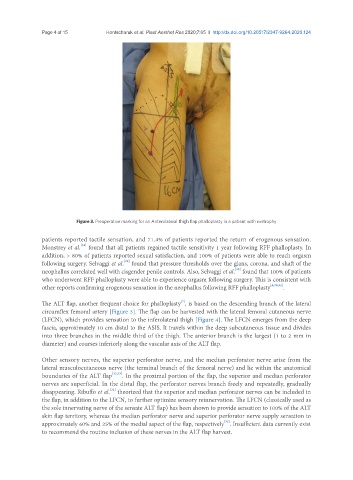Page 767 - Read Online
P. 767
Page 4 of 15 Hontscharuk et al. Plast Aesthet Res 2020;7:65 I http://dx.doi.org/10.20517/2347-9264.2020.124
Figure 3. Preoperative marking for an Anterolateral thigh flap phalloplasty in a patient with exstrophy
patients reported tactile sensation, and 71.4% of patients reported the return of erogenous sensation.
[24]
Monstrey et al. found that all patients regained tactile sensitivity 1 year following RFF phalloplasty. In
addition, > 80% of patients reported sexual satisfaction, and 100% of patients were able to reach orgasm
[29]
following surgery. Selvaggi et al. found that pressure thresholds over the glans, corona, and shaft of the
neophallus correlated well with cisgender penile controls. Also, Selvaggi et al. found that 100% of patients
[29]
who underwent RFF phalloplasty were able to experience orgasm following surgery. This is consistent with
other reports confirming erogenous sensation in the neophallus following RFF phalloplasty [8,30,31] .
The ALT flap, another frequent choice for phalloplasty , is based on the descending branch of the lateral
[7]
circumflex femoral artery [Figure 3]. The flap can be harvested with the lateral femoral cutaneous nerve
(LFCN), which provides sensation to the inferolateral thigh [Figure 4]. The LFCN emerges from the deep
fascia, approximately 10 cm distal to the ASIS. It travels within the deep subcutaneous tissue and divides
into three branches in the middle third of the thigh. The anterior branch is the largest (1 to 2 mm in
diameter) and courses inferiorly along the vascular axis of the ALT flap.
Other sensory nerves, the superior perforator nerve, and the median perforator nerve arise from the
lateral musculocutaneous nerve (the terminal branch of the femoral nerve) and lie within the anatomical
boundaries of the ALT flap [32,33] . In the proximal portion of the flap, the superior and median perforator
nerves are superficial. In the distal flap, the perforator nerves branch freely and repeatedly, gradually
[32]
disappearing. Ribuffo et al. theorized that the superior and median perforator nerves can be included in
the flap, in addition to the LFCN, to further optimize sensory reinnervation. The LFCN (classically used as
the sole innervating nerve of the sensate ALT flap) has been shown to provide sensation to 100% of the ALT
skin flap territory, whereas the median perforator nerve and superior perforator nerve supply sensation to
[32]
approximately 60% and 25% of the medial aspect of the flap, respectively . Insufficient data currently exist
to recommend the routine inclusion of these nerves in the ALT flap harvest.

